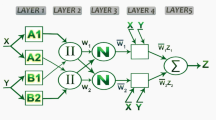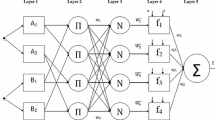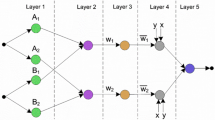Abstract
In this paper, a new version of IPO called (VLIPO- Variable Length Inclined Planes System Optimization Algorithm) has been provided primarily. Then, an efficient tool for simultaneous design and training of an ANFIS (adaptive neuro-fuzzy inference system) has been proposed using the mentioned algorithm. It should be noted that till the present time, related research has been only dealing with finding type and location of membership functions or proposing a method of training such networks. Length of standard versions of heuristic algorithms has been mainly the reason for not specifying the type and location of membership and training an ANFIS network simultaneously. For the same reason, first, a new version of the IPO is introduced with such factors being variable. Then, such capability is used for specifying the type and location of membership functions and simultaneous training of an ANFIS classifier. It goes without saying that the idea of making variations in search factors could be also implemented in other heuristic methods. Some of them have been reported in the research. Therefore, the presented idea in the paper may be applied to other heuristic methods and used in the design and simultaneous training of an ANFIS. So, the results from the comparison made between implementing the proposed method and other methods of which a version with a variable length has been previously reported (PSO, ACOR, DE, and GA) have been presented in several well-known databases. The results showed the better execution of ANFIS classifier designed by VLIPO compared to other heuristic methods.























Similar content being viewed by others
Notes
Variable Length Inclined Planes System Optimization algorithm
References
Lee CCC (1990) Fuzzy logic in control systems: fuzzy logic controller II. IEEE Trans Syst Man Cybern 20:404–418. https://doi.org/10.1109/21.52551
Ross TJ (2010) Fuzzy Logic with Engineering Applications, Third edn. Tata McGraw-Hill Publishing Company limited, New Delhi
Zahiri S-H (2010) Swarm Intelligence and Fuzzy Systems (Computer Science, Technology and Applications): Seyed-Hamid Zahiri:March 1, 2011
Klose A, Kruse R Enabling neuro-fuzzy classification to learn from partially labeled data. In: 2002 IEEE World Congress on Computational Intelligence. 2002 IEEE International Conference on Fuzzy Systems. FUZZ-IEEE’02. Proceedings (Cat. No.02CH37291). IEEE, pp 803–808
Ishibuchi H, Nakashima T, Murata T (1999) Performance evaluation of fuzzy classifier systems for multidimensional pattern classification problems. IEEE Trans Syst Man Cybern Part B 29:601–618. https://doi.org/10.1109/3477.790443
Shi Y, Eberhart R, Chen Y (1999) Implementation of evolutionary fuzzy systems. IEEE Trans Fuzzy Syst 7:109–119. https://doi.org/10.1109/91.755393
Setnes M, Roubos H (2000) GA-fuzzy modeling and classification: complexity and performance. IEEE Trans Fuzzy Syst 8:509–522. https://doi.org/10.1109/91.873575
Wang C-H, Hong T-P, Tseng S-S (1998) Integrating fuzzy knowledge by genetic algorithms. IEEE Trans Evol Comput 2:138–149. https://doi.org/10.1109/4235.738978
Xing Z, Hou Y, Tong Z, Jia L (2006) Construction of Fuzzy Classification System Based on Multi-objective Genetic Algorithm. In: Sixth International Conference on Intelligent Systems Design and Applications. IEEE:1029–1034
Rania C, Deepa SN (2010) PSo with mutation for fuzzy classifier design. In: Procedia Computer Science. Elsevier, pp 307–313
Chen CC (2006) Design of PSO-based fuzzy classification systems. Tamkang J Sci Eng 9:63–70
Alipour H, Asl EK, Esmaeili M, Nourhosseini M (2008) ACO-FCR : Applying ACO-Based Algorithms to Induct FCR. I:
Zahiri S-H, Seyedin S-A (2009) Using Multi-Objective Particle Swarm Optimization for Designing Novel Classifiers. Swarm Intelligence for Multi-objective Problems in Data Mining, In, pp 65–92
Jang JSR (1993) ANFIS: Adaptive-Network-Based Fuzzy Inference System. IEEE Trans Syst Man Cybern 23:665–685. https://doi.org/10.1109/21.256541
Kar S, Das S, Ghosh PK (2014) Applications of neuro fuzzy systems: A brief review and future outline. Appl Soft Comput J 15:243–259. https://doi.org/10.1016/j.asoc.2013.10.014
Zangeneh AZ, Mansouri M, Teshnehlab M, Sedigh AK (2011) Training ANFIS system with DE algorithm. In: The Fourth International Workshop on Advanced Computational Intelligence. IEEE:308–314
Nasiri M, Faez K (2012) Extracting fetal electrocardiogram signal using ANFIS trained by genetic algorithm. In: 2012 International Conference on Biomedical Engineering. ICoBE 2012:197–202
Sarkheyli A, Zain AM, Sharif S (2015) Robust optimization of ANFIS based on a new modified GA. Neurocomputing 166:357–366. https://doi.org/10.1016/j.neucom.2015.03.060
Rini DP, Shamsuddin SM, Yuhaniz SS (2016) Particle swarm optimization for ANFIS interpretability and accuracy. Soft Comput 20:251–262. https://doi.org/10.1007/s00500-014-1498-z
Karaboga D, Kaya E (2016) An adaptive and hybrid artificial bee colony algorithm (aABC) for ANFIS training. Appl Soft Comput 49:423–436. https://doi.org/10.1016/j.asoc.2016.07.039
Thangavel K, Kaja Mohideen A (2016) Mammogram Classification Using ANFIS with Ant Colony Optimization Based Learning. Springer, Singapore, pp 141–152
Ghasemi E, Kalhori H, Bagherpour R (2016) A new hybrid ANFIS–PSO model for prediction of peak particle velocity due to bench blasting. Eng Comput 32:607–614. https://doi.org/10.1007/s00366-016-0438-1
Marzi H, Haj Darwish A, Helfawi H (2017) Training ANFIS Using the Enhanced Bees Algorithm and Least Squares Estimation. Intell Autom Soft Comput 23:227–234. https://doi.org/10.1080/10798587.2016.1196880
Karaboga D, Kaya E (2018) Adaptive network based fuzzy inference system (ANFIS) training approaches: a comprehensive survey. Artif Intell Rev:1–31. https://doi.org/10.1007/s10462-017-9610-2
Mozaffari MH, Abdy H, Zahiri SH (2016) IPO: An inclined planes system optimization algorithm. Comput Informatics 35:222–240
Kennedy J, Eberhart R (1995) Particle swarm optimization. Neural Networks, 1995 Proceedings, IEEE Int Conf 4:1942--1948 vol.4 . doi: 10.1109/ICNN.1995.488968
Bäck T (1996) Evolutionary algorithms in theory and practice : evolution strategies, evolutionary programming, genetic algorithms. Oxford University Press
Chelouah R, Siarry P (2000) A Continuous Genetic Algorithm Designed for the Global Optimization of Multimodal Functions. J Heuristics 6:191–213. https://doi.org/10.1023/A:1009626110229
Storn, R.; Price K Differential evolution - a simple and efficient heuristic for global optimization over continuous spaces. J Glob Optim 11 - 1223 731–752
Socha K, Dorigo M (2008) Ant colony optimization for continuous domains. 185:1155–1173 . doi: https://doi.org/10.1016/j.ejor.2006.06.046
Eswari S, Raghunath PN, Sugun K (2008) Ductility performance of HyFRC. Am J Appl Sci 5:1257–1262
Bache K, Lichman M (2013) UCI Machine Learning Repository. Univ. Calif. Irvine Sch. Inf.:2008
FISHER RA (1936) The use of multiple measurements in taxonomic problems. Ann Eugen 7:179–188. https://doi.org/10.1111/j.1469-1809.1936.tb02137.x
Jurado F, Ortega M, Carpio J (2006) Power quality enhancement in fuel cells using genetic algorithms and ANFIS architecture. In: 2006 IEEE International Symposium on Industrial Electronics. IEEE, pp 757–762
Cardenas JJ, Garcia A, Romeral JL, Kampouropoulos K (2011) Evolutive ANFIS training for energy load profile forecast for an IEMS in an automated factory. In: ETFA2011. IEEE:1–8
Omar F, Lutfy OF, Noor SBM, Marhaban MH (2011) A simplified adaptive neuro-fuzzy inference system (ANFIS) controller trained by genetic algorithm to control nonlinear multi-input multi-output systems. Sci Res Essays 6:6475–6486. https://doi.org/10.5897/SRE11.1059
Ho W-H, Chen J-X, Lee I-N, Su H-C (2011) An ANFIS-based model for predicting adequacy of vancomycin regimen using improved genetic algorithm. Expert Syst Appl 38:13050–13056. https://doi.org/10.1016/j.eswa.2011.04.109
Wei Zhang, Jiang Zhu, Li Fang Kong (2011) Gradient genetic algorithm-based performance fault diagnosis model. In: 2011 2nd International Conference on Artificial Intelligence, Management Science and Electronic Commerce (AIMSEC). IEEE, pp 3059–3062
Fang KL, Zhe W, Wei Z (2011) ANFIS-based fault diagnosis cloud model of oil parameter for automobile engine. In: 2011 International Conference on Mechatronic Science, Electric Engineering and Computer (MEC). IEEE:2458–2462
Khosravi A, Nahavandi S, Creighton D (2011) Prediction Interval Construction and Optimization for Adaptive Neurofuzzy Inference Systems. IEEE Trans Fuzzy Syst 19:983–988. https://doi.org/10.1109/TFUZZ.2011.2130529
Wang R, Zhang J, Zhang Y, Wang X (2012) Assessment of human operator functional state using a novel differential evolution optimization based adaptive fuzzy model. Biomed Signal Process Control 7:490–498. https://doi.org/10.1016/J.BSPC.2011.09.004
Wang J, Gao XZ, Tanskanen JMA, Guo P (2012) Epileptic EEG Signal Classification with ANFIS Based onF Harmony Search Method. In: 2012 Eighth International Conference on Computational Intelligence and Security. IEEE:690–694
Turki M, Bouzaida S, Sakly A, M’Sahli F (2012) Adaptive control of nonlinear system using neuro-fuzzy learning by PSO algorithm. In: 2012 16th IEEE Mediterranean Electrotechnical Conference. IEEE:519–523
Nhu HN, Nitsuwat S, Sodanil M (2013) Prediction of stock price using an adaptive Neuro-Fuzzy Inference System trained by Firefly Algorithm. In: 2013 International Computer Science and Engineering Conference (ICSEC). IEEE:302–307
Karaboga D, Kaya E (2013) Training ANFIS using artificial bee colony algorithm. Ieee Inista 2013:1–5. https://doi.org/10.1109/INISTA.2013.6577625
Karaboga D, Kaya E (2014) Training ANFIS using artificial bee colony algorithm for nonlinear dynamic systems identification. In: 2014 22nd Signal Processing and Communications Applications Conference (SIU). IEEE:493–496
Tsai J-T, Chiu K-Y, Chou J-H (2015) Optimal Design of SAW Gas Sensing Device by Using Improved Adaptive Neuro-Fuzzy Inference System. IEEE Access 3:420–429. https://doi.org/10.1109/ACCESS.2015.2427291
Rouhibakhsh K, Darvish H, Sabzgholami H, Goodarzi MS (2018) Application of ANFIS-GA as a novel and accurate tool for estimation of interfacial tension of carbon dioxide and hydrocarbon. Pet Sci Technol 36:1143–1149. https://doi.org/10.1080/10916466.2018.1465959
Karaboga D, Kaya E (2018) Training ANFIS by Using an Adaptive and Hybrid Artificial Bee Colony Algorithm (aABC) for the Identification of Nonlinear Static Systems. Arab J Sci Eng:1–17. https://doi.org/10.1007/s13369-018-3562-y
Haznedar B, Kalinli A (2018) Training ANFIS structure using simulated annealing algorithm for dynamic systems identification. Neurocomputing 302:66–74. https://doi.org/10.1016/J.NEUCOM.2018.04.006
Saee AD, Baghban A, Zarei F, Zhang Z, Habibzadeh S (2018) ANFIS based evolutionary concept for estimating nucleate pool boiling heat transfer of refrigerant-ester oil containing nanoparticles. Int J Refrig 96:38–49. https://doi.org/10.1016/J.IJREFRIG.2018.08.002
Semero YK, Zheng D, Zhang J (2018) A PSO-ANFIS based Hybrid Approach for Short Term PV Power Prediction in Microgrids. Electr Power Components Syst 46:95–103. https://doi.org/10.1080/15325008.2018.1433733
Author information
Authors and Affiliations
Corresponding author
Additional information
Publisher’s Note
Springer Nature remains neutral with regard to jurisdictional claims in published maps and institutional affiliations.
Rights and permissions
About this article
Cite this article
Soltany Mahboob, A., Zahiri, S.H. Variable Length IPO and its application in concurrent design and train of ANFIS systems. Appl Intell 49, 2233–2255 (2019). https://doi.org/10.1007/s10489-018-1366-0
Published:
Issue Date:
DOI: https://doi.org/10.1007/s10489-018-1366-0




